Famous Churches in Iran; From Vank to Saint Thaddeus
Iran is home to Shia Islam, which is one of the largest sects of Islam and the official religion of Iran.
However, other religions, such as Christianity, Zoroastrianism, and Judaism, are also practiced in this country. Therefore, Iran is no stranger to Christianity, as the history of this heavenly religion in Iran dates back to the early years of faith, pre-dating Islam.
The Most Famous Churches in Iran
There are roughly 300,000 Christians in Iran and at least 600 churches around the country; 90 are listed as national monuments, and three are also known as world heritage sites. While we cannot cover all the churches, We invite you to see some of the churches in Iran.
What are the Most Famous Churches in Iran?
- Saint Thaddeus Church
- Saint Stepanos Monastery
- Saint Dzor Dzor Monastery
- Vank Cathedral
- Saint Sarkis Cathedral
- Saint Mary Church (Holy Mother of God Church)
- Saint Thaddeus and Bartholomeus Church
- Saint Garapet Church
- Maar-Sargiz Historical Church
- Church of Saint Mary (Naneh Maryam Chruch)
- Cantor Church (The Little Red Church)
- Beit-ol Lahm Church
1. Armenian Monastic Ensembles of Iran
1.1) Saint Thaddeus Church
Location: Maku
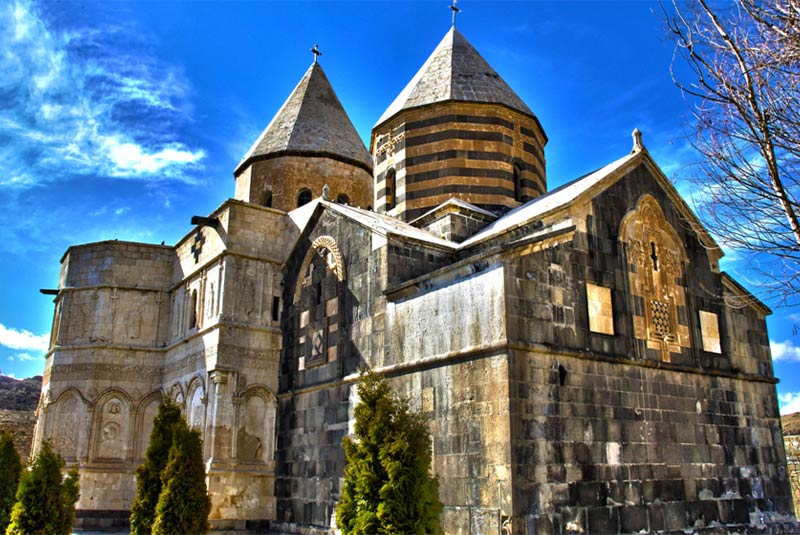
The Monastery of Saint Thaddeus is one of Iran's oldest and most famous churches that carries great significance for the Armenian Orthodox community in Iran and neighboring countries. It was added to UNESCO's World Heritage Sites in 2008. Qare Church is also known as Black Church. It is located in West Azerbaijan Province. The monastery annually gathers Armenian Christians from Iran and neighboring countries for different ceremonies and religious celebrations. Armenian Christians believe the Qare church is the world's first church and the tomb of the sacred Thaddeus, who preached Christianity in the vicinity of Azerbaijan, thereby gaining many followers, including the daughter of the monarch of the time. To stop the advancement of Christianity, the Armenian ruler ordered his massacre in 66 AD, and he was buried in the church. This church comprises two sections; the 'Black Church', the earliest part; hence its Turkish name Kara Kilise, the Black Church, and the 'White Church', the new part of the church.
1.2) Saint Stepanos Monastery
Location: Jolfa
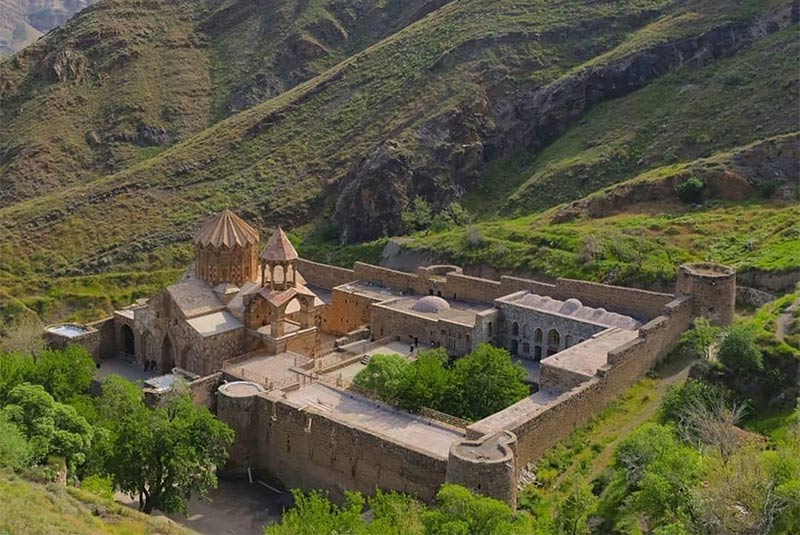
The Saint Stepanos Monastery is located about 15 kilometers northwest of Jolfa in the famous valley of 'Sham'. It is the second most crucial Armenian church in Iran, and its name is also on The World Heritage List. Saint Stepanos monastery is situated in the heart of the mountains and the middle of the green nature between the border of Jolfa city and the Azerbaijan Republic. A stone fence protects the Saint Stephanos monastery, and the designs on the stone have made it a unique monument famous among visitors.
Saint Stepanos Monastery was constructed in the 9th century AD, but an earthquake seriously damaged it. So, it was refurbished in the Safavid period. Also, Abbas Mirza took measures in the Qajar era to maintain and repair it. This monastery is also known as Saint Stefan Monastery. The holy saint Stefan was one of the apostles of Christ and the first martyr of Christianity, and among the first missionaries of parochialism. He was stoned to death in December in Jerusalem on charges of rendering a speech contrary to Jewish law. Saint Stepanos is a holy figure in different religions, which has resulted in many churches and monasteries with his name worldwide.
1.3) Saint Dzor Dzor Monastery
Location: Maku
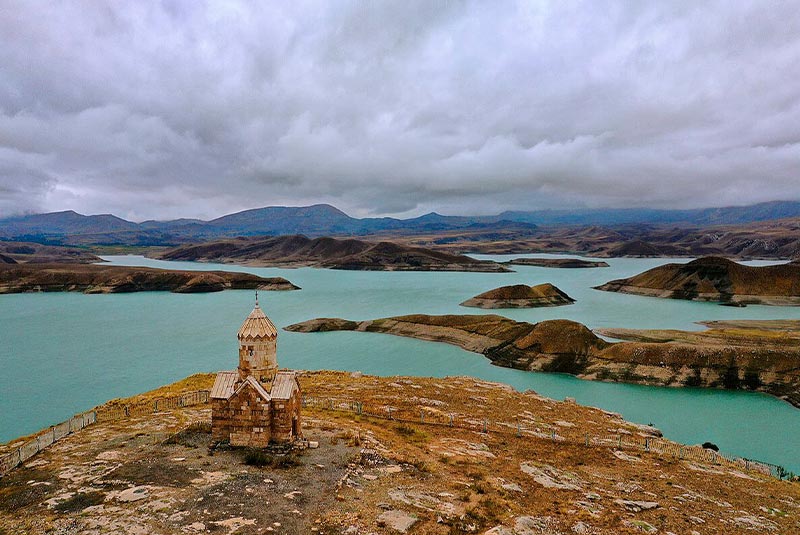
The Chapel of Dzor Dzor is a historic temple near the town of Maku. Saint Dzor Dzor Monastery is also known as Saint Mary Church. The church is registered on The UNESCO World Heritage List. The monastery was built with the efforts of Archbishop Zakaria Bestachi. The monastery was a theological school and later became one of Iran's important centers of Armenian calligraphy. Priest Hwens Zurzortesi also called Zor Zoretsi, teaches theology in this monastery. He taught 12 respected Catholic church leaders in this monastery, including the Bishop of Hovens, who was made an Archbishop in 1330 and was overseen by the Kerna Scientific Center (an essential center of the Catholic Church in the Nakhichevan region). One of this church's most crucial and fascinating aspects is that it was not built in its original location. It has been relocated throughout history due to a project known as the Baron Reservoir Dam in 1366. This dam delivered water to the Maku town plain's agriculture. Upon completion of the construction of the dam, the Cultural Heritage Organization's Executive Directorate relocated the church to protect this unique structure. This relocation is regarded as one of the most significant events in maintaining Iran's cultural and historical legacy and has yet to be replicated. The inscription installed on the church's wall points out the reasons for the church's relocation. At the same time, it bears testimony to the importance of preserving the cultural and historical heritage of the country.
The Chapel of Dzor Dzor is a historic temple near the town of Maku. Saint Dzor Dzor Monastery is also known as Saint Mary Church. The church is registered on The UNESCO World Heritage List. The monastery was built with the efforts of Archbishop Zakaria Bestachi. The monastery was a theological school and later became one of Iran's important centers of Armenian calligraphy. Priest Hwens Zurzortesi also called Zor Zoretsi, teaches theology in this monastery. He taught 12 respected Catholic church leaders in this monastery, including the Bishop of Hovens, who was made an Archbishop in 1330 and was overseen by the Kerna Scientific Center (an essential center of the Catholic Church in the Nakhichevan region). One of this church's most crucial and fascinating aspects is that it was not built in its original location. It has been relocated throughout history due to a project known as the Baron Reservoir Dam in 1366. This dam delivered water to the Maku town plain's agriculture. Upon completion of the construction of the dam, the Cultural Heritage Organization's Executive Directorate relocated the church to protect this unique structure. This relocation is regarded as one of the most significant events in maintaining Iran's cultural and historical legacy and has yet to be replicated. The inscription installed on the church's wall points out the reasons for the church's relocation. At the same time, it bears testimony to the importance of preserving the cultural and historical heritage of the country.
2. Vank Cathedral
Location: Isfahan
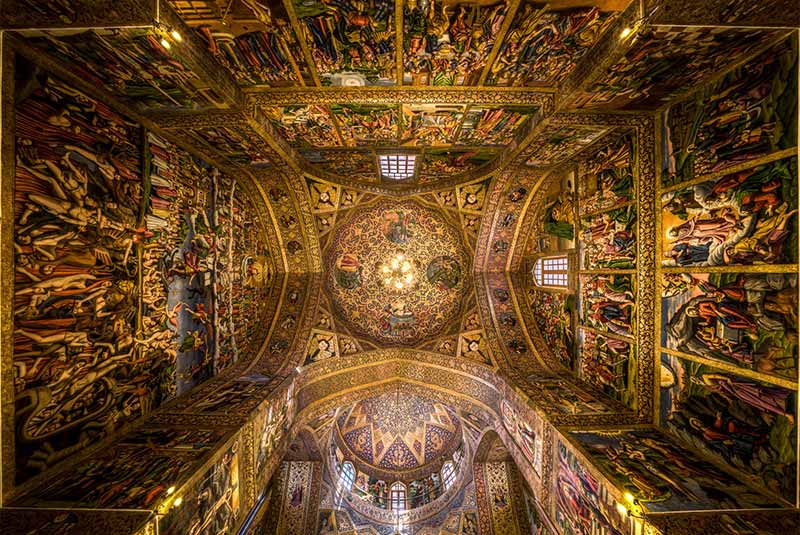
Vank Cathedral is also known as Holy Savior Cathedral. It is among the most spectacular tourist attractions of Isfahan. It is also one of the most beautiful and prominent churches in Iran, in the Jolfa vicinity of Esfahan. Vank Cathedral was built during the Safavid era by the hundreds of thousands of Armenians forcibly relocated by Shah Abbas I in his new capital during the Ottoman War of 1603-1618. The gilded ceiling, the dome's internal section, and the fine historical paintings of this church are matchless. The structure of the cathedral dome is similar to the Safavid-era mosques, but what makes it so unique is its interior paintings and gildings. The interior is covered with delicate frescos, gilded carvings, and a wainscot of rich tile work. The central dome is decorated with light blue and gold paint, depicting the Biblical story of the world's creation and man's expulsion from Eden. In addition, two murals run around the cathedral's interior walls: the top section displays events from the life of Jesus Christ, and the bottom section shows tortures inflicted upon Armenian martyrs by the Ottoman Empire.
| Read the complete article: Vank Cathedral | Persian & Armenian Cultural Masterpiece
3. Saint Sarkis Cathedral
Location: Tehran
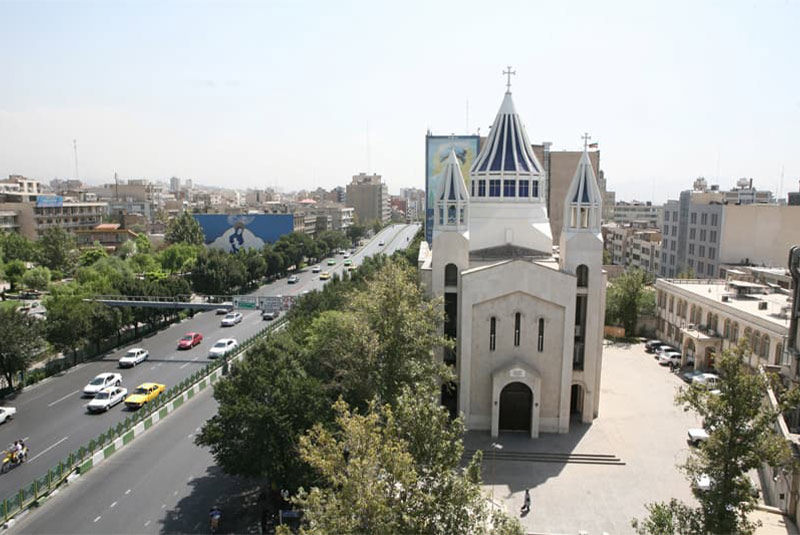
Saint Sarkis Cathedral is an Armenian church in the central part of Tehran built in 1970. It is considered the largest church in Tehran. The exterior part of this cathedral is simple and made of white marble. The cathedral's interior walls are covered with paintings with biblical themes telling stories from Christianity, such as Jesus' baptism, ascension, crucifixion, and so forth. Saint Sarkis Cathedral is divided into different sections:
- A sanctuary
- A chapel
- A baptism bunker
- A space for musicians
- Two private chambers designed for specific needs
There is also a memorial in the cathedral's courtyard to remember the Ottoman Empire's systematic extermination of over 1.5 million Armenians between 1914 and 1923.
4. Saint Mary Church (Holy Mother of God Church)
Location: Tabriz
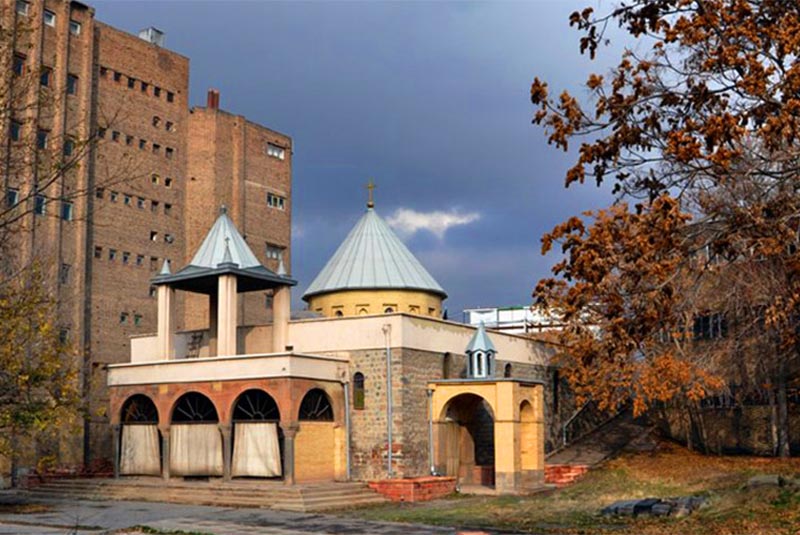
Tabriz Holy Mother of God Church is one of the largest and oldest churches in Tabriz, East Azerbaijan Province, Iran. It is also known as Surp Mariam Asdvadzadzin Church. The church is considered the main center of religious practice among Armenians in Tabriz; each year, many religious ceremonies are held here. Saint Mary's church was built in the 12th century AD. According to the oldest gravestone, the age of Saint Mary Church of Tabriz is estimated to date back to 1600. The famous Venetian traveler Marco Polo referred to this church in his book of travels when he was on his way to China. The architecture of Saint Mary Church of Tabriz pursues the rules of Christian style. Its central dome is placed on four thick stone columns. A small marble inscription is above the main gate to the church on which its establishment date is carved. There are also eight stone columns on which the big bell of the church is installed. The church's walls are decorated with beautiful paintings of the Virgin Mary, Jesus Christ, and his followers. Two paintings above the four central columns have been destroyed due to moisture, and only the other two are left. This is one of the churches in Iran that have paintings on canvas fabric on their walls. The miniature technique of the paintings belongs to the year 1800 and is European in its style.
5. Saint Thaddeus and Bartholomeus Church
Location: Tehran
Saint Thaddeus and Bartholomeus Church is the first temple built by Armenians in Tehran. It is located on Mowlavi Street near Tehran's Grand Bazaar. The Armenian families brought to Tehran from Isfahan under the orders of the Qajar King, Fath Ali Khan, created the church. He wanted these Armenians, who were well-known craftsmen, to decorate his royal palaces, which are located in the now Golestan Palace Complex. This church is one of the most ancient churches of Tehran, constructed at the end of the 12th century AH. Few Armenian Christians and foreign cultural and political figures, including a Georgian prince, are laid to rest in this church.
6. Saint Garapet Church
Location: Abadan
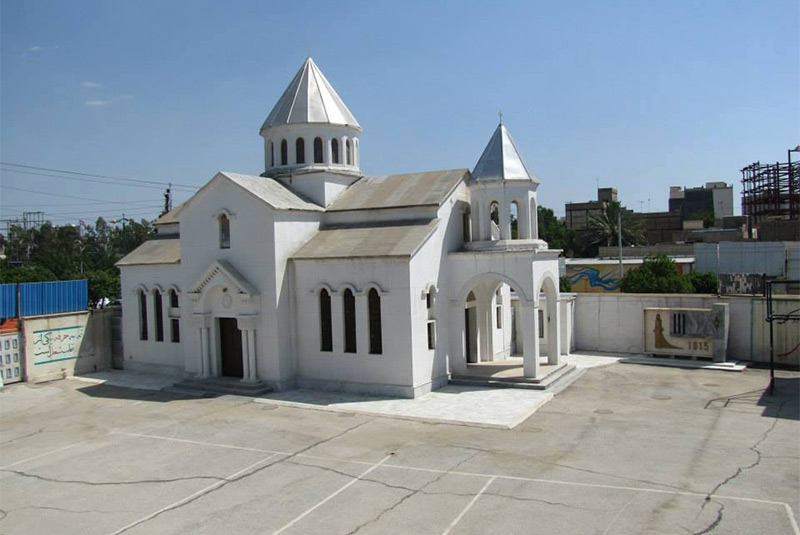
Saint Garapet church is located in Abadan City. This church was established in 1958 and is famous among foreign and domestic tourists. The church's round columns and bronze conical-shaped domes add to its grandeur and contribute to the beauty of Abadan City. The church also has white walls and four brown wooden doors with two relief crosses on each one. It also has two domes; the large dome is placed on the central part of the church, and the small dome is on the posterior aspect. Near the southern gate of the church, there is an epigraph that says: "Everywhere we are … we will not forget you", along with the painting of an Armenian mother and her child that is the reminiscence of the Armenian Genocide by the Ottoman Empire during World War I.
The church also has a rectangular hall decorated with chandeliers, columns, navy blue and red curtains, picture frames, wooden benches, and wall carpets with Christian motifs. The hall has fourteen semicircular windows held by external cross fences. In the hall is a candle-lit Meron cup, the holy oil of Armenia's Etchmiadzin Cathedral, and a notebook. The church's altar is semicircular, with four columns built about seven stairs above the ground level. A large tableau of Jesus Christ is placed between the two altar columns, around which there are two golden candlesticks. There are two wooden doors on the altar for the priest and the choir group. The most exciting point about this church is that it is adjacent to the famous Imam Musa ibn Jafar mosque. It beautifully represents the respect and connection between people from different religions. During the 8-year Iran-Iraq war, this mosque was turned into a center for training and preparing soldiers. Few Christian people live in this city; therefore, fewer ceremonies are held in St. Garapet church.
7. Maar-Sargiz Historical Church
Location: Urmia
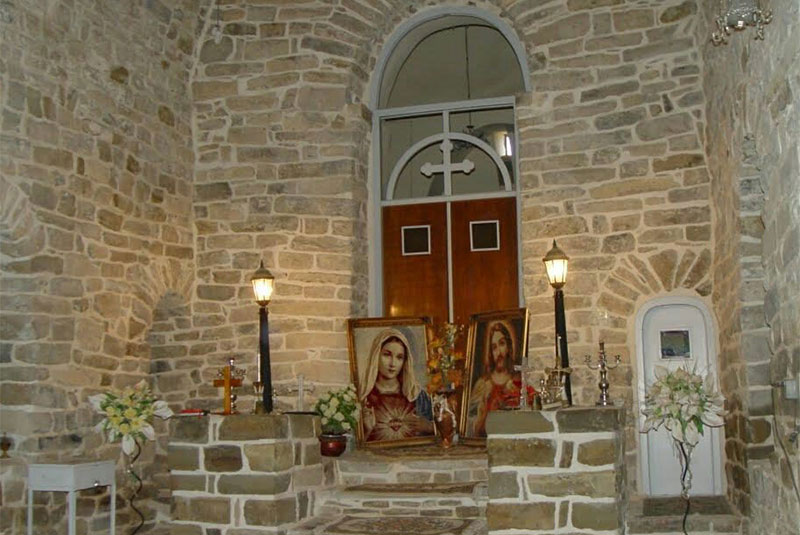
Maar-Sargiz Historical Church, also called Marserkis, Marsarkis Church, and Sir Church, is located 12 km West of the city of Urmia on the Ser Mountain. This historic church was built under the orders of Shirin (the wife of the Sassanian ruler Khosrow Parviz), who was a Christian follower. The building consists of two parts that are joined together. The first part consists of an entrance hall, prayer and altar, and the second part of the hall is to be built parallel to the first hall. An internal input connects the two. Both sides of the church-style arches are party-Sassanid, and Tavizeh vaults with a horseshoe-shaped cradle. The church is a place of pilgrimage for Assyrian Christians.
8. Church of Saint Mary (Naneh Maryam Chruch)
Location: Urmia
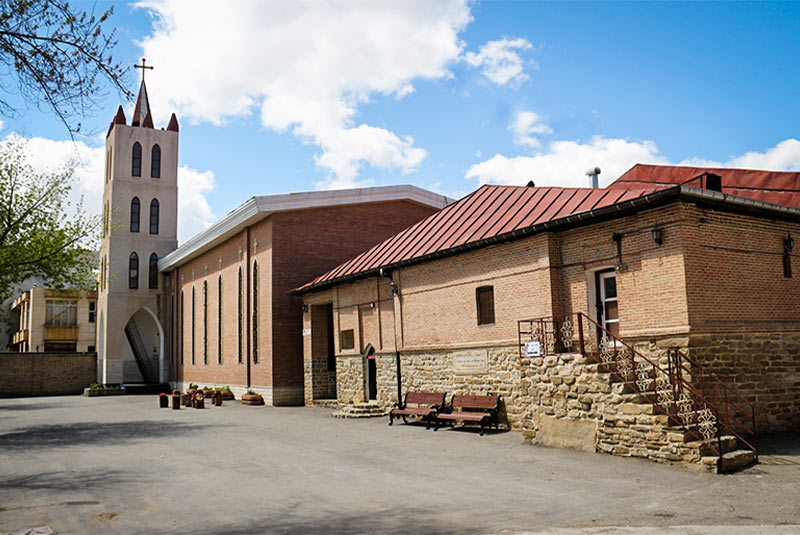
Saint Mary Church is also known as Naneh Maryam Church. It is an ancient Assyrian church in Urmia. It is considered the second oldest church in Christendom after the Church of the Nativity in Bethlehem on the West Bank. Archaeological experts attribute Saint Mary's Church to Sassanid Period based on examining and studying its internal architecture, domes, arches, and pillars. However, Some Assyrian and Christian historians believe it had been a Fire temple at first in which three Zoroastrian priests used to pray. At Jesus Christ's birth, these three priests observed a shining star moving toward the east. They considered it as a sign of awaited Messiah's birth and traveled to Jerusalem to meet him. After coming back, they converted the fire temple into a church. The church encompasses an altar, several chambers, a vestibule, and the main hall.
9. Cantor Church or The Little Red Church
Location: Qazvin
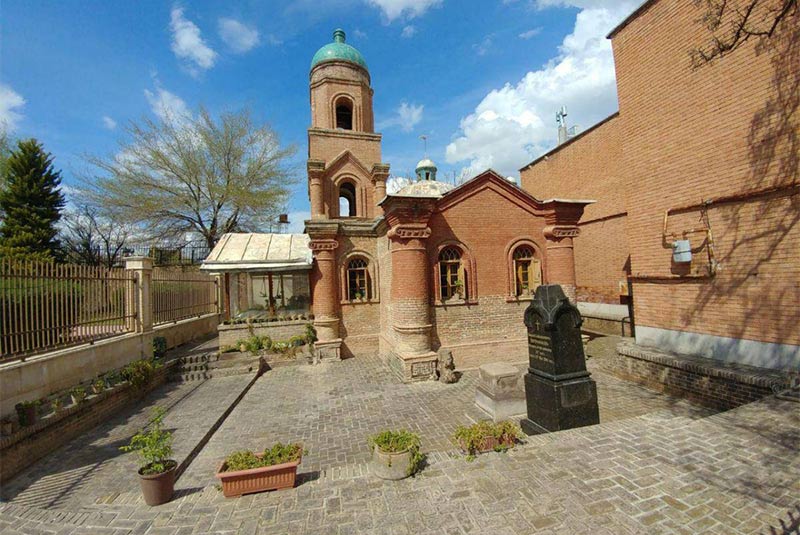
Cantor church is a Russian Orthodox church in Qazvin, easily recognizable by its red bricks and turquoise dome tiles. The church is also known as the Bell Tower. The church has a cruciform design with a large dome in the center of the chapel. It also has a smaller dome at the top of the east-facing altar. The entrance of the church is located on the western side, and it has a pitched roof at the gate. After the entry, there is an anteroom above which a three-story bell tower is erected about eleven meters high with a small dome. The Russian crosses, which hang only on the two sides of the entrance walls, indicate the nationality of its creators. The large pillars of the church are designed to double its beauty, and its carpet yard looks as magnificent as it is. The churchyard is relatively tiny, and there are tombstones around it. One of the tombs marked with a black stone belongs to a Russian engineer named Nikolai Alexandrovich, who died at the age of 9 in the solar year. In addition to the tombstone, another stone in the church owned by a Russian pilot reportedly crashed around the city during World War I, and the body of the pilot was buried inside the church. The construction of this church began After Nasser-e-Din Shah's (Qajar King r. 1848-1896) visit to France, and he ordered the construction of roads between the cities to connect Tehran with Europe. The road Tehran – Qazvin was built by Saad al-Saltanah, Qazvin's later governor, but the Anzali road construction was performed by a Russian company called "Insurance and Transport ", and Russian engineers built the little red church in Qazvin during the construction project.
10. Beit-ol Lahm Church
Location: Isfahan
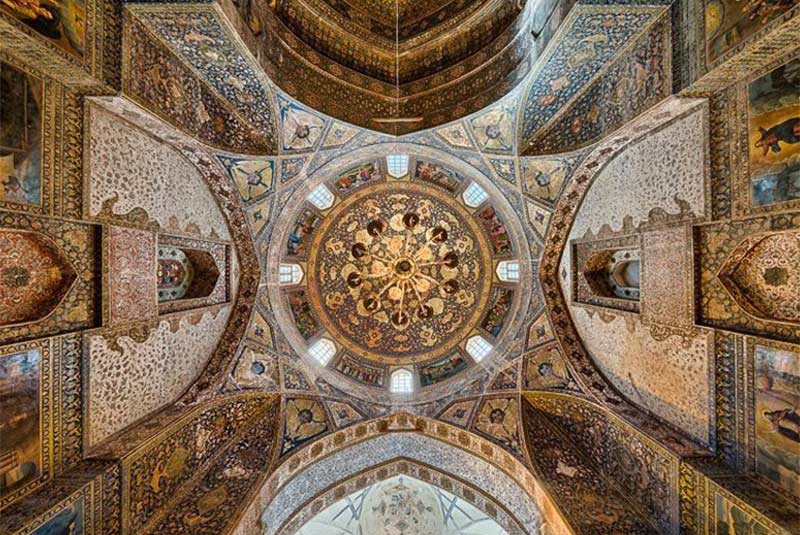
Beit-ol Lahm church is located in Jolfa Square. It was built by an Armenian man called Khajeh Petros Vali Janian. The portrait of this man is on the wall of the church
Other Churches in Iran
Surp Sarkis Church (Saint Sarkis)
Location: Khoy
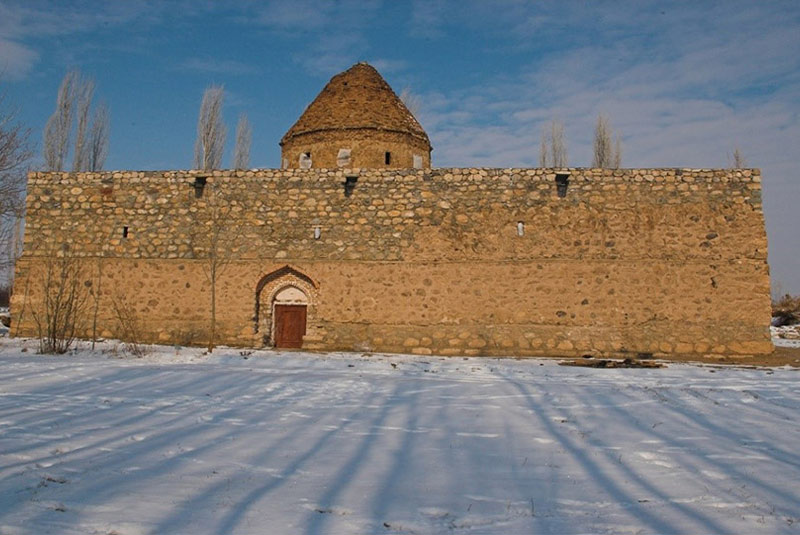
Surp Sarkis Church or Saint Sarkis church dates back to the 4th century AD. It is on The Cultural Heritage Organization records. This old Armenian church is located in Khoy. The architecture of Iranian temples heavily inspired the architecture of the Saint Sarkis Cathedral. It has two entrance doors on the south and western sides. Surp Sarkis Cathedral has six columns made of stones inside it. Eight small holes supply the lightening of the interior side. The altar is located on the northeast part of the cathedral and is the only section decorated with religious paintings on the plaster. Looking at the facade, you see a small dome that crowns the central part. The construction was built and decorated with lime stones carved into a cube. St. Sarkis Church is believed to date from the 4th century though most of what visitors see there dates back to the Safavid era when it dominantly underwent restoration works.
Mahalzan Church
Location: North of Khoy in the village of Mahlazan
This old Armenian church is said to be related to the Mongol or Safavid periods.

Khark Old Church, Khark Island
Location: Khark Island
Belongs to the Christians of the Sassanian era.

Hakoop Church
Location: Isfahan
Hakoop church is the first Armenian church in Esfahan territory. It was built in 1065 AH after the Armenian Christians immigrated to this vicinity.
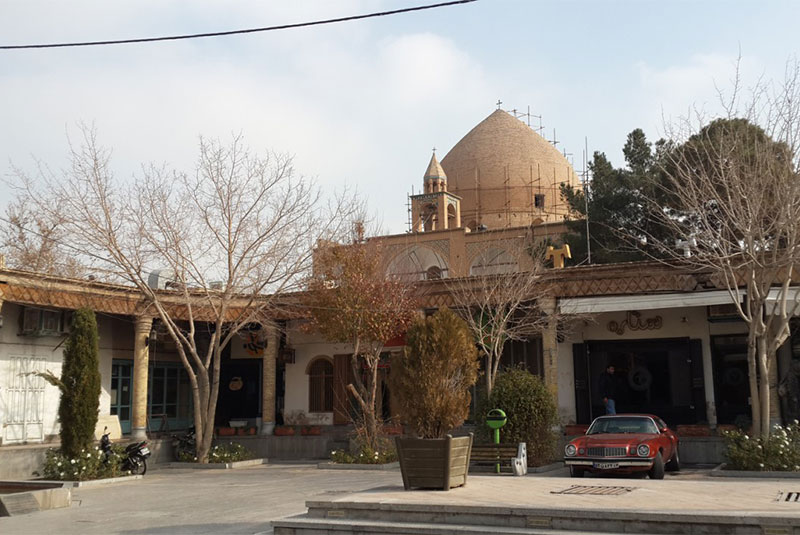
Christian Church, Sarjooy
Location: Shiraz
This church is situated in the Armenian sector of Sarjooy. The main hall and paintings of the church with plasterwork and ornaments date back to the Safavid period.
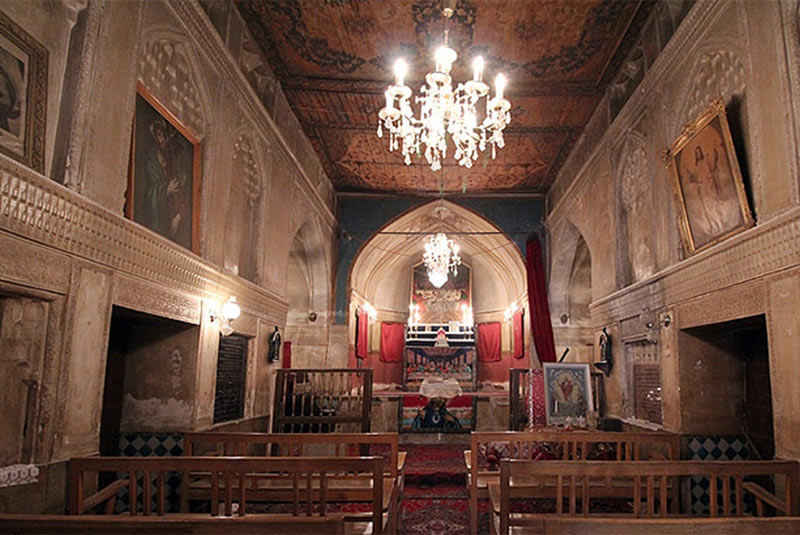
Sarkis Church
Location: Tabriz
Saint Sarkis Church was constructed by 'Petrossian' in the Banvan neighborhood of Tabriz in 1821 AD. The church, which has Armenian architecture, is made of stone, has a brick dome, and is built in the shape of a cross. There is a monument outside the church dedicated to fallen Armenians.
Holy Mary Church in Ardabil
Location: Ardabil

The church of the Virgin Mary (Holy Maryam Church) is located in the Armanestan Alley or Ounchoo Meydan (Unchi Square) in Ardabil. It dates back to about 300 years ago. Ardabil church was constructed in 1876 AD. The interior decorations of the church are fascinating, and its wooden door is ornamented with intricately carved geometrical designs. Due to the location of Ardabil on the silk route, from a long time ago, this city was the place of commitment of merchants and tourists with different religions. But the relation of this city to Christianity dates back to very long eras. This building was constructed at the expense of Armenian Galvest Mirzaeian and the efforts of Khajatur Shahbazian. This church, with its oldness of two centuries, has been active till 1944 AD, and the last rituals and congregational prayer were done in 1944 AD by priest Vartan Jamagorsian. From this date on, due to the migrations of Armenian families to Tabriz and Tehran, rituals have been canceled in this church. Now, the belongings of this church, including the bath and school, have been destroyed, and its building has been abandoned and ruined.


Comment
Leave a Comment